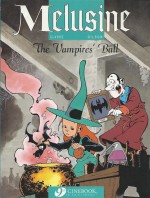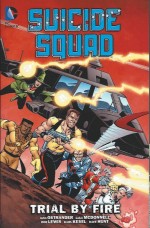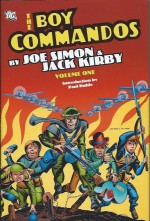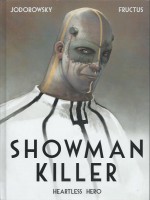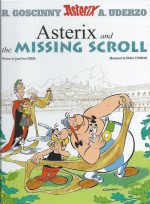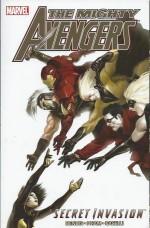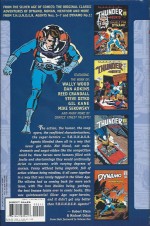
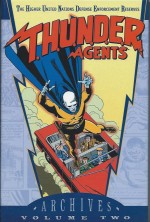
By Wally Wood, Steve Ditko, Dan Adkins, John Giunta, Gil Kane, Reed Crandall, Mike Sekowsky, Steve Skeates & various (DC Comics)
ISBN: 978-1-56389-970-6
The history of Wally Wood’s immortal comics masterpiece is convoluted, and once the mayfly-like lifetime of the Tower Comics line folded, not especially pretty: wrapped up in legal wrangling and lots of petty back-biting. None of that, however, diminishes the fact that the far-too brief run of The Higher United Nations Defense Enforcement Reserves was a benchmark of quality and sheer bravura fun for fans of both the still-reawakening superhero genre and the popular media’s spy-chic obsession.
In the early 1960s the James Bond movie franchise was going from strength to strength, with action and glamour utterly transforming the formerly understated espionage vehicle. The buzz was infectious: soon A Man like Flint and Matt Helm were carving out their own piece of the action even as television shanghaied the entire bandwagon with the irresistible Man from U.N.C.L.E. (which premiered in September 1964), bringing the whole genre inescapably into living rooms across the world.
Before long wildly creative cartooning maverick Wally Wood was approached by veteran MLJ/Archie Comics editor Harry Shorten to create a line of characters for a new distribution-chain funded publishing outfit – Tower Comics. Woody called on some of the biggest names in the industry to produce material in the broad range of genres the company requested (as well as T.H.U.N.D.E.R. Agents and its spin-offs Undersea Agent, Dynamo and NoMan, there was the magnificent war-comic Fight the Enemy and the youth-comedy Tippy Teen).
Samm Schwartz and Dan DeCarlo handled the funny book – which outlasted all the others – whilst Wood, Larry Ivie, Len Brown, Bill Pearson, Steve Skeates, Dan Adkins, Russ Jones, Gil Kane and Ralph Reese all contributed scripts for themselves and the industry’s top talents to illustrate on the assorted adventure series.
With such a ravenous public appetite for super-spies and costumed heroes steadily rising in comic-book popularity the idea of blending the two concepts seems a no-brainer now, but those were far more conservative times, and when T.H.U.N.D.E.R. Agents #1 appeared with no fanfare or pre-publicity on newsstands in August 1965, thrill-hungry readers were blown away.
It didn’t hurt either that all Tower titles were in the beloved-but-rarely-seen 80 Page Giant format: there was a huge amount to read in every issue!
All that being said the tales would not be so adored by us baby-boomer fans if they hadn’t been so superbly crafted. As well as Wood, the art accompanying the compelling, far more mature stories was by some of the greatest talents in comics: Reed Crandall, Kane, George Tuska, Mike Sekowsky, Dick Ayers, Joe Orlando, Frank Giacoia, John Giunta, Steve Ditko and others.
This second lush and lustrous hardback compilation collects T.H.U.N.D.E.R. Agents #5-7 and the first blockbusting issue of spin-off title Dynamo – from June to August 1966 – with the superbly cool concept and characters going from strength to strength.
Following a positively passionate and insider-fact packed Foreword by Robert Klein and Michael Uslan, the stunning all-star action blast off like a rocket…
For those who came in late: When brilliant Professor Emil Jennings was attacked by the forces of the mysterious Warlord, the savant perished but UN troops salvaged some of his greatest inventions. These included a belt that increased the density of the wearer’s body until it becomes as hard as steel, a cloak of invisibility and a brain-amplifier helmet.
The prototypes were divided between several agents to create a unit of super-operatives to counter increasingly bold attacks of many global terror threats such as the aforementioned Warlord.
First chosen was affable, honest but far from brilliant file clerk Len Brown who was, to everyone’s surprise, assigned the belt and codename Dynamo. Contributing scripter Len Brown had no idea illustrator/editor Wood had puckishly changed the hero’s civilian name as a last-minute gag until the comic rolled off the presses…
T.H.U.N.D.E.R. Agent NoMan was once aged Dr. Anthony Dunn who chose to have his mind transferred into an android body and was then gifted with the invisibility cape. If his artificial body was destroyed Dunn’s consciousness could transfer to another android body. As long as he had a spare ready, he could never die…
John Janus seemed the perfect UN employee: a mental and physical marvel who easily passed all the tests necessary to wear the Jennings helmet. Sadly, he was also a deep cover mole for the Warlord, poised to betray T.H.U.N.D.E.R. at the earliest opportunity. All plans went awry once he donned the helmet and became Menthor. The device awakened his mind’s full potential, granting him telepathy, telekinesis and mind-reading powers, but it also drove all evil from his mind. When the Warlord attacked with a small army and a giant monster, Menthor was compelled by his own costume to defeat the assault. What a dilemma for a traitor to be in…
A fourth super-spy was added when Guy Gilbert of the crack Mission: Impossible style T.H.U.N.D.E.R. Squad was required to beta-test an experimental super-speed suit. The gung-ho hyper-fast Lightning was proud to do so, even if every use of the hyper-acceleration gimmick shortened his life-span…
T.H.U.N.D.E.R. Agents #5 again gloriously pandered to every kid’s dream as the nice guy with the power to smash was pinpointed as the weak link of the agency and subjected to a three-pronged attack by Warlord and his subterranean race in ‘Dynamo and the Golem’ by a sadly unrecorded writer with art from Crandall, Wood & Adkins. The stupendous underground duel with the monstrous mechanical was even augmented by guest walk-ons (a rare treat in the mid-1960s when most editors feared over-exposing their heroes) by other T.H.U.N.D.E.R. stars…
The modern master of a tribe of primordial men returned as ‘NoMan: In the Caverns of Demo’ (by Bill Pearson, Gil Kane, Wood & Tony Coleman) saw the invisible agent lured into a trap and temporarily lose his wonder cape. After a gloriously panoramic ‘Lightning Pin-up’ by Adkins, Steve Skeates, Mike Sekowsky & Frank Giacoia then reveal how a Nazi scientist blackmails a trusted engineer and wrecks new planes for the agency with his deadly “slow-down†dust in ‘Lightning: Return of Baron Von Kampf’…
The author of ‘Menthor vs. The Entrancer’ is unknown but the unmistakable John Giunta limns the dark tale of the mind master’s duel with a petty thief who steals a magic gem and almost conquers a country before the concluding ‘T.H.U.N.D.E.R. Agents: Double For Dynamo’ (Skeates, Wood, Adkins & Coleman) sees the entire team unite to tackle another plot by duplicate maker Mastermind to place his felonious android facsimiles in positions of power…
Issue #6 opened with ‘Dynamo and the Sinister Agents of the Red Star’ (author unknown, Wood & Adkins) as the sinister Sino-spymaster introduced a devastating judo expert who could use the human powerhouse’s strength against him. Len had to use his brain (for a change) to stop the brazen theft of America’s newest super-submarine…
Skeates, Sekowsky & Giacoia had fun with a teleporting criminal in ‘Lightning: The Origin of the Warp Wizard’ and shockingly let the villain win whilst in ‘T.H.U.N.D.E.R. vs. Demo’ – illustrated by Giunta, Wood & Adkins – the vile plotter ambushed NoMan and used his stolen cape to gather tons of cash and the other Jennings devices.
The arrogant thug’s big mistake was trusting his sultry sidekick Satana, who oddly bore a grudge for that time he abandoned her to T.H.U.N.D.E.R. and the cops…
‘Menthor: The Carnival of Death’ with art by Giunta & Carl Hubbell pitted the agent against a spy who was a natural telepath. Despite tremendous odds Janus foiled an insidious assassination attempt but lost his helmet in the process…
The best tale in this issue – and probably the entire book – is ‘NoMan: To Fight Alone’ by Skeates & Ditko wherein the immortal agent is the only one capable of defying anti-democratic demagogue Mr. Image who has the power to control any and all living beings in his vicinity. Of course, NoMan is only “living†is a strictly technical sense…
The final T.H.U.N.D.E.R. Agents inclusion is #7; a true landmark which opens with Dynamo in ‘Wanted: Leonard Brown, Code Name “Dynamo†Suspicion of Treason’ (illustrated by Wood, Adkins & Ralph Reese) with the hero on the run. Gullible Brown has been framed by the delectable Rusty (revealed as the svelte and sinister Iron Maiden; a vivacious villainess clad in figure-hugging steel who was the probable puberty trigger for an entire generation of boys…) but still manages – as much by charm and luck as skill or wit – to turn the tables and vindicate himself, after which a frantic showdown leaves Lightning possibly crippled for life after enduring ‘The Warp Wizard’s Revenge’ (Skeates, Sekowsky & Giacoia).
The years-long secret war against invaders from Earth’s core came closer to final resolution in ‘T.H.U.N.D.E.R. Agents: Subterranean Showdown’ – art by George Tuska – as a council of Warlords’ abduction of Dynamo leads to a shattering battle they ultimately fail to win, whilst, after a pulse-pounding Wood & Adkins ‘Iron Maiden: Pin-up’, NoMan suffers a psychological breakdown in ‘To Be or Not To Be’ by Pearson, Giunta & Sal Trapani.
Although Dr. Dunn is now a thing of plastic and wire, he is still susceptible to feminine allure and the unresolved dilemma almost costs him – and Earth – everything…
The issue ended with a tale which blew the mind of most kids reading it in the summer of 1966. ‘Menthor: A Matter of Life and Death’ written by Adkins, with art by Ditko & Wood was an utter shock to readers who had never seen a hero die before (we were so sheltered back then; cowboys and cops only ever shot guns out of owlhoots’ hands)…
When a super-agent is shanghaied to Subterraneana as bait for a trap, he does what any hero would do rather than betray his friends…
This cathartic fun-fest concludes with the contents of Dynamo #1 as the Tower’s top draw was the first hero to get his own solo title. It began with sheer sci fi spectacle as T.H.U.N.D.E.R. spots a staging post on Luna and sends Len on what might be a one-way trip (it’s three years before the Apollo moon shots, remember?) to scotch a potential invasion from space in ‘Menace From the Moon’ by Wood & Adkins.
That astounding blockbuster is followed by a deliciously wry romp as ‘A Day in the Life of Dynamo’ (Sekowsky & Giacoia) finds the invulnerable operative harried around the world from pillar to post in pursuit of the elusive Red Dragon, the wicked Warlords, rampaging giant robots… and a date with the boss’ assistant Alice…
Then Crandall, Wood & Adkins seemingly take Dynamo ‘Back to the Stone Age’: revealing the secret of Demo’s stock of cavemen and dinosaurs after the devilish villain breaks out of jail with Mastermind in tow, after which Ditko, Wood & Adkins craft another mini-masterpiece as ‘Dynamo Meets the Amazing Andor’.
Decades ago the so-very-patient Warlords stole a human baby and spent long years turning the waif into a biological superman devoid of sentiment or compassion. Sadly, when they finally unleashed their Andor on the surface civilisations, although they anticipated the dogged resistance of humanity and even the newly-constituted T.H.U.N.D.E.R., the subterranean geniuses hadn’t factored in their living weapon’s reaction to the first woman he had ever seen…
The tongue-in-cheek dramas wrap up with a bright breezy spoof as ‘Wonder Weed, Super Hero’ illustrated by Giunta, reveals how merely mortal – and mildly jealous – agent William “Weed†Wylie is tricked by a magician/enemy agent into thinking he has powers too. Of course Weed is gullible and avaricious but nobody’s fool…
With stories all shaded in favour of fast pace, sparse dialogue, explosive action and big visuals, T.H.U.N.D.E.R. Agents was decades ahead of its time and certainly informed everything in Fights ‘n’ Tights comics which came after it. These are truly timeless comic classics which improve with every reading, and there’s never been a better time to add these landmark superhero sagas to your collection of favourites.
© 1966 John Carbonaro. All rights reserved. This edition © 2003 DC Comics.


